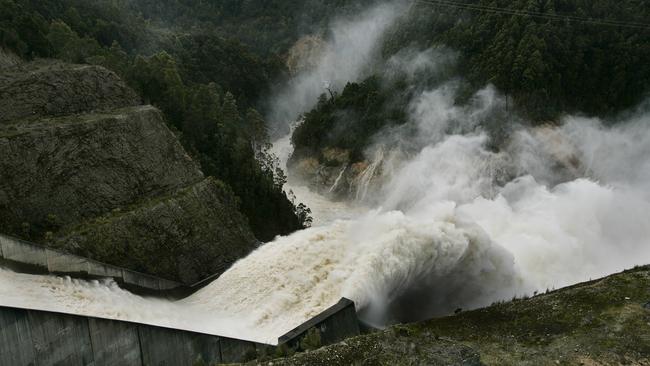Race is on for the nation’s best hydro plans
THE viability of the Tasmanian Government’s “Battery of the Nation” idea would be affected by progress on Snowy Hydro 2.0, an energy analyst says.

Tasmania
Don't miss out on the headlines from Tasmania. Followed categories will be added to My News.
THE viability of the Tasmanian Government’s “Battery of the Nation” idea would be affected by progress on Snowy Hydro 2.0 and the pace of decline in domestic battery costs, an energy analyst says.
On Saturday, the Mercury reported Hydro Tasmania’s plan to develop pumped hydro and up to three new Bass Strait interconnectors so Tasmania could supply interstate markets with renewable energy as coal plants close.
MORE: CAN TASMANIA BE THE BATTERY OF THE NATION?
Goanna Energy consultant Marc White said: “The global race is on to find who has the lowest backup cost for renewable energy.
“The Australian energy market is stepping over gas in the process.”
He said natural gas-fired generation was once expected to bridge the gap in the transition from coal power to renewable energy, but massive gas price rises had resulted in the market focusing on batteries and pumped hydro.
Mr White said it was likely there would be huge movement in the cost and the effectiveness of domestic batteries by the time pumped hydro could be developed.
Meanwhile Greens energy spokesman Nick McKim said pumped hydro was a pipe dream.
“[Energy Minister Matt] Groom’s pumped hydro fantasy is highly unlikely to be competitive or economically viable, and would cause significant environmental damage to Tasmania’s World Heritage Wilderness Area,” Senator McKim said.
“He has gone off completely half-cocked.
“The future of Tasmania’s, and indeed Australia’s, energy lies in distributed renewable generation and storage.
“That means more small scale renewable projects across our state, giving more control to local communities.”
But Energy Minister Josh Frydenberg said it was the “perfect solution” because it “is baseload power and carbon free”.
Meanwhile, the Federal Government said it had extracted a promise from AGL chief Andy Vesey to take a proposal to his board to consider selling or extending past 2022 the life of the coal-fired Liddell power station in NSW.
Mr White said there could be massive changes to the nature of battery storage by the time a seven-year build was completed.
Household use of solar energy and batteries could make overall energy demand fall over coming years.
“People want to take control of their own costs and there will be more and more of it especially as people realise they can, at least in the short term, avoid network costs,” he said.
He said Tesla would be chasing exactly the same market with its batteries.
Mr White said the Hydro Tasmania plan would be competing with Snowy Hydro 2.0 which has been championed by Prime Minister Malcolm Turnbull and which is undergoing a $36 million Australian Renewable Energy Agency feasibility study.
“Snowy will have an advantage because it is closer to the major markets in NSW and Victoira and may have lesser transmission investment required,” he said.
With the help of a $5 million ARENA feasibility study, Hydro Tasmania aims to identify 10 to 15 pumped hydro sites where water can be reused after being pumped back uphill using excess wind energy.
Pumped hydro and redevelopment of the Tarraleah power station and an additional turbine at the Gordon power station could double Tasmania’s generating capacity to 5000 megawatts.
Mr White said Snowy Hydro 2.0 and Hydro Tasmania 2.0 would be competing for the same off-peak electricity, to pump the water back uphill, which could result in prices being increased for existing off-peak users.
“There are dairy farms, supermarkets, aged care homes and other businesses which rely heavily on using cheap off-peak power and if that rises it could put their viability at task,” he said.
He said future hydro inflows under climate change scenarios would also be a risk.


